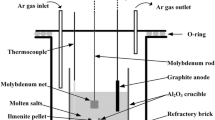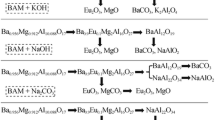Abstract
Comprehensive CeMgAl11O19: Tb3+ (CTMA) disintegration via alkaline fusion was discussed. The rare earth (RE) elements in CTMA were dissolved by HCl completely after alkaline fusion. Relationships between the alkaline fusion temperature and various properties of the compounds were examined by various techniques to elucidate their roles in the expected CTMA disintegration. X-ray diffraction (XRD) analysis indicates the phase transformation sequence. A scientific hypothesis of crystal structure disintegration presents that sodium ions substitute for the europium and barium ions in the mirror plane and magnesium ions in the spinel block successively, resulting in that more oxygen vacancies and interstitial sodium ions appear. The unit cell [P63/mmc (194)] breaks from the mirror plane. Then it is decomposed into NaAlO2, and magnesium, cerium, and terbium ions combine with free OH− into MgO, Tb2O3 and CeO2; Tb2O3 and CeO2 change into Ce0.6Tb0.4O2−x . In the end, the rare earth oxide is recycled easily by the acidolysis. The mechanism provides fundamental basis for recycling of REEs from waste phosphors.








Similar content being viewed by others
References
Humphries M. Rare Earth Elements: the Global Supply Chain. Washington, D.C: DIANE Publishing; 2010. 2.
Xu KD, Ren ZM, Li CJ. Progress in application of rare metals in superalloys. Rare Met. 2014;33(2):111.
Yang C, Hou YL. Advance in the chemical synthesis and magnetic properties of nanostructured rare-earth-based permanent magnets. Rare Met. 2013;32(2):105.
Reddy YS, Kiataiah P. Elastic properties of double layered manganites R1.2Sr1.8Mn2O7 (R = La, Pr, Nd, Sm). Rare Met. 2014;33(2):166.
Bünzli JCG, Pecharsky VK. Handbook on the Physics and Chemistry of Rare Earths, vol. 43. North Holland: Elsevier; 2013. 182.
European Commission. Critical raw materials for the EU. report of the ad-hoc working group on defining critical raw materials.(EC, Ed.). Brussels, 2010, 23.
Bauer D, Diamond D, Li J. Critical Materials Strategy. Washington, D.C: Department of Energy; 2011. 97.
Binnemans K, Jones PT, Blanpain B, Van GT, Yang Y, Walton A, Buchert M. Recycling of rare earths: a critical review. J. Clean Prod. 2013;51:1.
Zhang Q, Saito F. Non-thermal extraction of rare earth elements from fluorescent powder by means of its mechanochemical treatment. J Min Mater Inst Jpn. 1998;114:253.
Zhang Q, Lu J, Saito F. Selection extraction of Y and Eu by non-thermal acid leaching of fluorescent powder activated by mechanochemical treatment using a planetary mill. J Min Mater Inst Jpn. 2000;1162:137.
Takahashi T, Takano A, Saitoh T, Shigen-to-Sozai. Separation and recovery of rare earth elements from phosphor sludge in processing plant of waste fluorescent lamp by pneumatic classification and sulfuric acidic leaching. J Min Mater Inst Jpn. 2001;117:579.
Shimizu R, Sawada K, Enokida Y, Yamamoto I. Supercritical fluid extraction of rare earth elements from luminescent material in waste fluorescent lamps. J Supercrit Fuilds. 2005;33(3):235.
Horikawa T, Machida K. Reuse and recycle processing for rare earth phosphors. Mater Integr. 2011;24:37.
Stevels ALN. Ce3+ luminescence in hexagonal aluminates containing large divalent or trivalent cations. J Electrochem Soc. 1978;125(4):588.
Zhang J, Zhang Z, Tang Z, Lin Y. Mn2+ luminescence in (Ce, Tb) MgAl11O19 phosphor. Mater Chem Phys. 2001;72(1):81.
Liu H, Zhang S, Tian J, Yang M, Wu ML, Volinsky AA. Rare earth elements recycling from waste phosphor by dual hydrochloric acid dissolution. J Hazard Mater. 2014;272:96.
Zhang SG, Yang M, Liu H, Pan D, Tian JJ. Recovery of waste rare earth fluorescent powders by two steps acid leachin. Rare Met. 2013;32(6):609.
Mgaidi A, Jendoubi F, Oulahna D, Maaoui MEI, Dodds JA. Kinetics of the dissolution of sand into alkaline solutions: application of a modified shrinking core model. Hydrometallurgy. 2004;71(3):435.
Acknowledgments
The work was financially supported by the National Key Project of the Scientific and Technical Support Program of China (No. 2012BAC02B01), the National Hi-Tech R&D Program of China (No. 2012AA063202), the National Natural Science Foundation of China (No. 51472030), the Fundamental Research Funds for the Central Universities (Project No. FRF-TP-14-043A1), and the China Postdoctoral Science Foundation Funded Project (No. 2014M560885).
Author information
Authors and Affiliations
Corresponding author
Rights and permissions
About this article
Cite this article
Liu, H., Zhang, SG., Pan, DA. et al. Mechanism of CeMgAl11O19: Tb3+ alkaline fusion with sodium hydroxide. Rare Met. 34, 189–194 (2015). https://doi.org/10.1007/s12598-014-0439-4
Received:
Revised:
Accepted:
Published:
Issue Date:
DOI: https://doi.org/10.1007/s12598-014-0439-4




